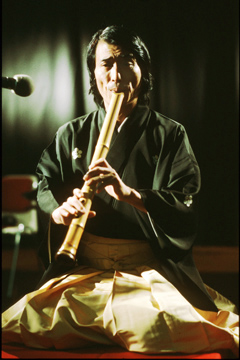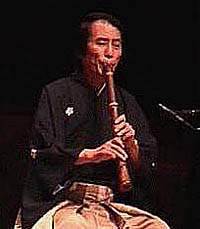
Hozan Yamamoto
SHAKUHACHI SHEET MUSIC
Folk Music Scores & Modern Compositions
|
|
Hozan Yamamoto SHAKUHACHI SHEET MUSIC
Folk Music Scores & Modern Compositions |
|
30 of the most popular folk music pieces written in 5-line staff notation arranged by Living National Treasure Hozan Yamamoto. Titles include:
Published in Japan. 64 pages. HS-1
|
|
Titles include: 1. BAMBOO DUET (1962). Part 1: Deep in the moso bamboo forest. Part 2: Young bamboo in the Japanese garden after rain. Part 3: Hoteichiku. Comical feeling of Buddha's Belly bamboo. 2. BAMBOO DUET-No. 2 (1963). Part 1: Calm and silence. Part 2: Sound and movement in the bamboo grove. Part 3: Staccato. 3. BAMBOO QUARTET (1962) explores harmony with four shakuhachi. Written for 1.6', 1.8', 2.1' and 2.3' length instruments. 4. BAMBOO TRIO (1965). Subtitled Oogi or "fan". Inspired by Gagaku, the ancient Imperial court music of Japan and scenes of the Japanese landscape. 5. MINUET FOR SHAKUHACHI (1956) is inspired by Strauss and the time in his life when Yamamoto Hozan played the Western silver flute. 6. MEIKA (1970) is the divine protection which culminates in the transition through death. Part 1: Delusion. Part 2: Inner Turmoil. Part 3: Joy. 7. SHO CHI (1967) means the home ground where all life originates. This piece explores the dynamic mystic nature of the life force. Published in Japan. 63 pages. HS-2
|
|
|
This Japanese language playing guide is written primarily in the five-line form, making the music of the shakuhachi accessible to anyone who is able to read western staff notation. The text is written in Japanese while the music is in western form. Hozan Yamamoto covers all aspects of shakuhachi: its history, mechanics, tuning and repair. He explains in detail how to hold and blow this instrument and provides the beginner with information on how to choose a quality shakuhachi. Chapters on playing explains how to read western staff and Japanese cursive notation with detailed information on rhythm, syncopation, tempo, staccato as well as techniques particular to shakuhachi playing. All aspects of honkyoku and sankyoku music are explored in this encyclopedic work. Nine pieces of folk (Minyo) and classical music
are provided along with eight advanced pieces including honkyoku and
Yamamoto's own compositions. Scores include the following titles: A supplementary fingering chart is included. 135 pages. PG-10
|
 |
Living National Treasure Hozan Yamamoto is one of the mostly highly regarded players and composers of modern shakuhachi music alive today. He was one of the first classical player in Japan to synthesize traditional and western forms of music. Learn more about Hozan Yamamoto |